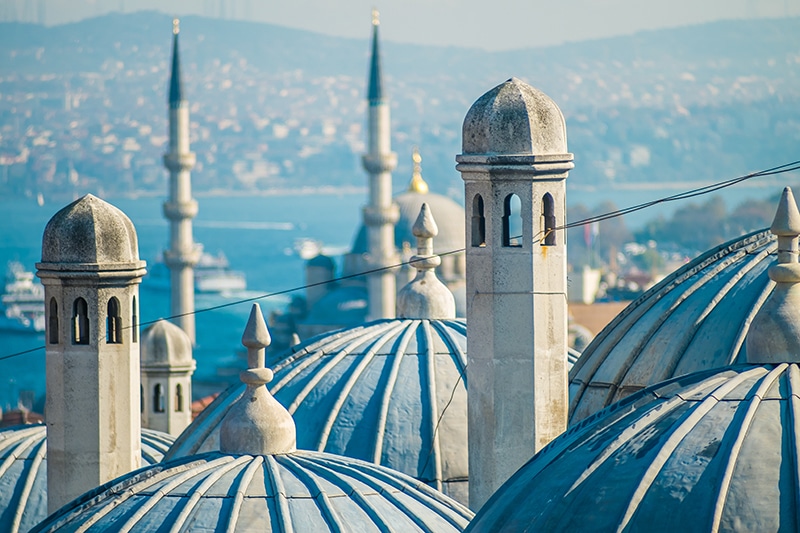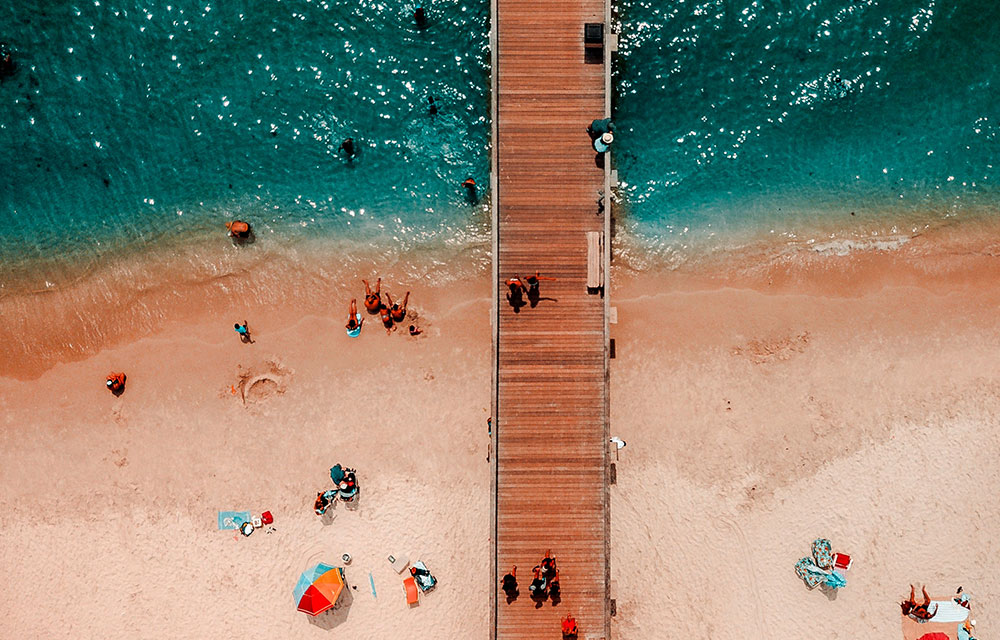Almost every wedding, destination, and hotel marketer has or is considering investing in a drone video. We went to the source to help you pick the right one.

New Castle, New Hampshire’s David Murray of ClearEyePhoto has enjoyed an interesting career, reaching back to a passion for amateur photography in high school, a high-flying Silicon Valley run through the ’90s and mid 2000s, and finally, into his own photography business over the last decade or so. He’s experimented with RC aircraft for decades and was an early adopter of the DJI Phantom. (He now flies the DJI Inspire-class drone.)
We spoke to him about best practices, do’s and don’ts, and the right moments to consider drone videography for your destination, hotel, and wedding venue marketing needs. (And a note on semantics: We’re using “drone videography” and “drone photography” interchangeably throughout this piece.)
Why is drone videography such a natural fit for those in hospitality marketing?
The value in many great hotels and wedding venues is that they’re based in a really special location. There’s no better tool for capturing and conveying a grand, beautiful setting than drone video.
What does drone photography offer that traditional aerial photography doesn’t?
If you get up in a plane or helicopter, it’s tough to get down low enough to capture the perspective, and if you’re on the ground, it’s hard to show the surroundings well. A couple hundred feet is the sweet spot, and you can really show the setting in a way that’s just magical. I love it. It’s always exciting to get the drone in the air and discover what you can see, with the client looking over your shoulder at the screen, because sometimes they spot things they didn’t expect.
How can hotels and venues find the right drone photographer for their project?
The first thing you should do is make sure the operator you’re planning on working with is certified by the FAA to do commercial drone operations. You should always operate legally – don’t hire people who aren’t certified. And they’re out there. If you have an FAA-certified drone pilot, it indicates that they have a sufficient interest in what they’re doing, have gone through the trouble, and are probably serious about it.
From there, you need to focus on their ability to take the photos and videos you want by evaluating their portfolio. If you haven’t looked at much drone photography or videography, use Google and YouTube to find examples that have won awards so you have some sort of point of reference. The images shouldn’t be hazy or unclear. No curved or tilted horizons or strange color. Broadly speaking, their video should be smooth and keep you engaged, with any music or narration fitting in well with the footage in terms of timing and mood.
Aside from that, it’s not much different from working with any other commercial photographer or videographer – they should be reliable, easy to communicate with, and capable of doing the type of work you’re looking for. Talking to past customers of theirs is helpful, and spending the time to talk to them about the project before you get too far into it is important, too.
What’s a common mistake drone videographers and their clients make?
The most common mistake I see is people thinking that drone shots stand alone as compelling storytelling, because the perspective seems unique to them. But there’s so much bad drone footage out there now that people are getting more used to it and beginning to tune it out, so we’re at the point where people want some story or drama. Sequencing scenes, tying in music effectively, mixing in ground shots – you have to put it together in a coherent roll that’ll take the viewer on a bit of a journey and draw them in and keep their interest. Finally, there are some basic photography principles to follow – I can’t believe how often I see drone photos shot with no regard for the sun. The image quality is really poor.
What are the technical specs drone photographers – and those hiring them – should be seeking these days?
As far as DJI drones are concerned, anyone who is serious about doing commercial work is flying at least a Phantom 4 Pro, or an Inspire 1 Pro or Inspire 2. This is especially true when capturing still photos for use in print media, where image quality needs to be higher than for use on websites and in social media. A key distinction between the cameras on these drones and the ones on older or lesser drones is the size of the image sensor. The older ones use the same size sensors used in most point-and-shoot cameras (about 1/2″), while the more capable drone cameras have larger sensors (1″ or 4/3″).
Generally speaking, image quality and low-light performance improve as sensor size increases. The lens quality is also better in the drones I’ve mentioned above. Phantom 3 Pro drones were great flying camera platforms when they came out, creating better stills than the best GoPros at the time, and almost as good video. But they are now pretty behind the times, using small sensors and inferior lenses. There are also older Inspire 1 drones out there whose “X3” camera is essentially the same as the camera in a Phantom 3 Pro.
Of course, the photographer’s skills are more important than just the camera itself. Just as a great photographer can often take a better picture with a cell phone camera than a poor photographer might take with a $3,000 dSLR he or she does not know how to use, a great drone photographer with a Phantom 3 might deliver better results than a poor photographer who’s using an Inspire 2 with X5s camera. So, it’s really most important to look at the quality of the work, rather than just the equipment itself.
Is drone photography being overused at this point?
I think done right, especially if there’s architecture involved, even if it’s a one story building, a drone can provide a valuable perspective. But the easy mistake to make is going up and showing context that you don’t want to show. If your resort is next to a trailer park or a quarry and you’re marketing it as a high-end property, it’s not a good idea to show it from that angle. A second example would be if you have a building that looks wonderful from a ground perspective, but has a flat roof with a bunch of ugly equipment, stains, and debris on top.
I hear people say “I’m supposed to shoot drone footage here,” so they fly around the building and technically capture drone footage, but don’t show any aspects of the building that would make anyone want to go there. It’s purely gratuitous at that point.
What do you think the best way to capture a wedding would be?
The key thing with wedding drone photography is to capture the setting, and to do it in a way that isn’t obtrusive. You typically don’t want to be buzzing around during the ceremony itself, unless the couple really wants that. It’s usually better to get a little farther away and get a shot where you can clearly see that there’s a wedding party there, but that they’re overlooking the golf course or ocean. The role of the drone is to capture context – just far enough away to show the setting beautifully.


